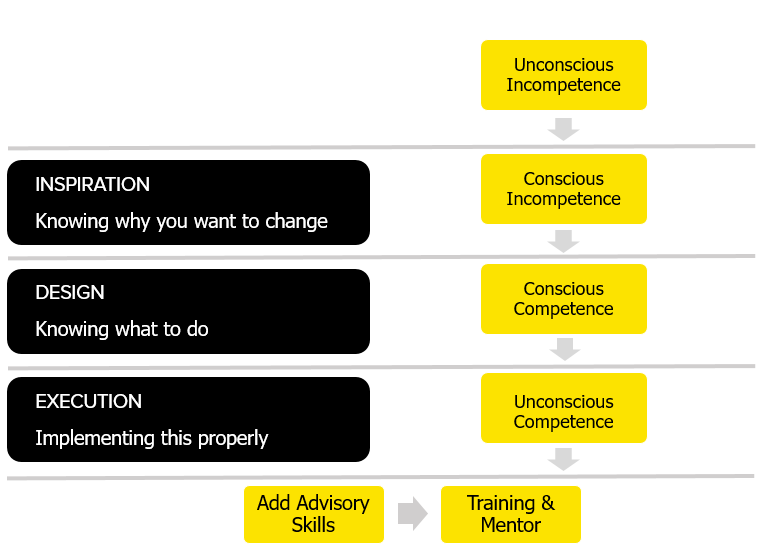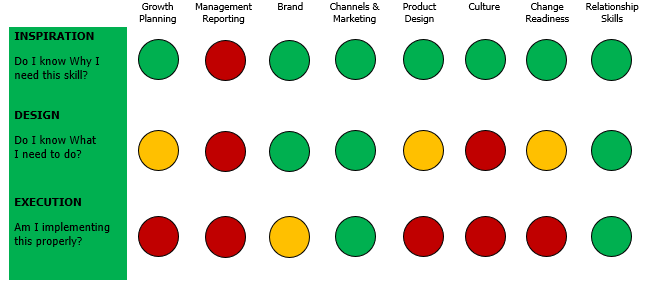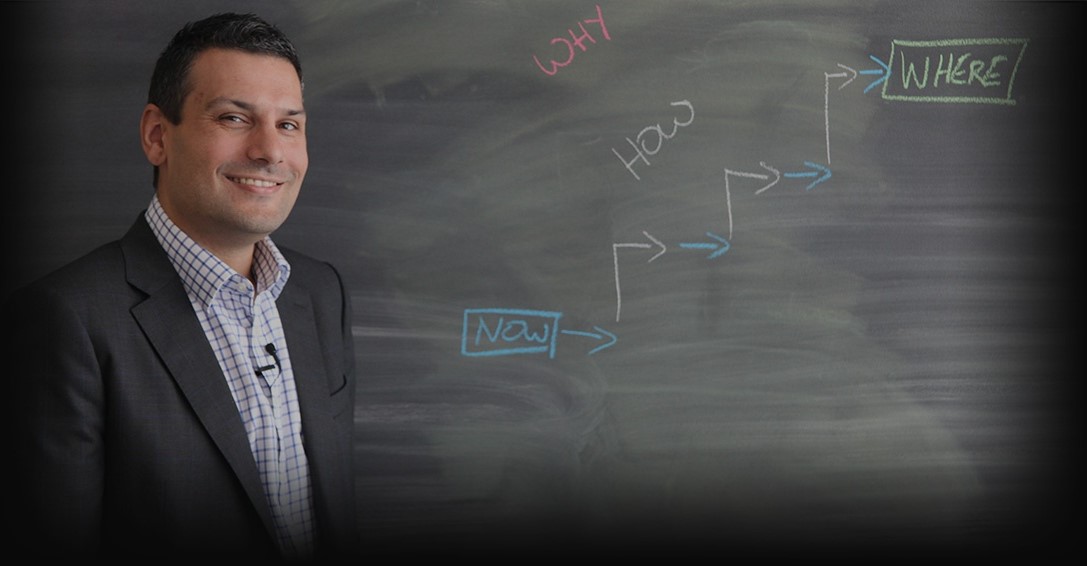How to Conducts a Training Needs Analysis for your Team. In Blackboard Fridays Episode 32, Jacob talks about Learning and Development. Need this implemented into your business? Talk to the international business advisor who can do exactly that – Contact Jacob, Learn More, or Subscribe for Updates.
In last week’s episodes we discussed a simple tool for measuring expertise – the journey from Unconscious Incompetence (where you’re useless, but you don’t know it) through to Unconscious Competence (where you’re awesome, and take it for granted).
It was a journey that went through Inspiration, Education, and Execution, and it’s excellent for objectively assessing how skillful you or one of your team are in a particular area.
This week we add steroids to the concept: how do we measure ALL of the skills your business needs, across ALL of your team members?
Because if you can do that, then you can build an annual training plan that effortlessly addresses overall business needs. You can push responsibility for skill development back on to individual team members. And you can design a career path through your organisation (and your industry) based on the growing capability an individual acquires – or can acquire, with the right training plan.
Naturally, the coloured chalk comes into play as well.
In 12 years of business coaching, personalising and completing Training Needs Analyses remains one of the most fun and valuable projects I undertake with my clients.
Please watch the video here and let me know if you have any questions.
Who is Jacob Aldridge, Business Coach?
“The smart and quirky advisor who gets sh!t done in business.”
Since April 2006, I’ve been an international business advisor providing bespoke solutions for privately-owned businesses with 12-96 employees.
At this stage you have proven your business model, but you’re struggling to turn aspirations into day-to-day reality. You are still responsible for all 28 areas of your business, but you don’t have the time or budget to hire 28 different experts.
You need 1 person you can trust who can show you how everything in your business is connected, and which areas to prioritise first.
That’s me.
Learn more here. Or Let’s chat.
Transcript
Happy Friday Blackboarders. Last week, we talked about some of the different levels of learning—how to understand for yourself or for a team member, objectively whether they were an expert or an impostor or felt like an impostor in this skill.
This week I want to take that and apply that to a broader business use. It’s one of the most common projects that I do with my mid-sized business clients, where we build out a Training Program for the business over the year.
And to do that, we need to start with a Training Needs Analysis.
The Depth of Skills and Layers of Learning
A Training Needs Analysis (or TNA) requires several elements, and it starts with having a clear, objective, and consistent framework to measure the level of expertise for each individual within your business.

As a quick refresh of last week:
- With any skill we start as Unconsciously Incompetent. We’re useless, and we don’t even know it.
- At some point we receive the “Inspiration” to understand that skill – we become Consciously Incompetent. We’re still useless but now we understand it.
- Then we go into the “Design” process. We get educated, we learn more we piece it all together, and now we understand how to do that skill. We become Consciously Competent.
- As we “Execute” that skill over time, we eventually move to a point where we are Unconsciously Competent. At this level, we can do that skill and we don’t even need to actively think about it anymore.
So this framework can be applied to understand the layers of learning for any particular skills.
When designing a training plan, or conducting a needs analysis for a business, we need another element – not just the depth of understanding, but the breadth of different skills an individual may require to perform their role.
Go Wide
You may have noticed in my weekly introduction, I talk about how I help business owners across all 28 areas of a business.
So naturally, at a strategic skill level, I have a Training Needs Analysis template of all 28 different business skills that I believe business owners with growing businesses need to understand at least down to level a design or an execution point.
For your business, to apply this to most of your team, you’re going to want to include some technical skills as well (or instead – 28 is already a lot).
Blackboard Fridays was done in partnership with businessDEPOT Accounting, for example; when conducting a Training Needs Analysis for their team, we know they need some specific accounting skills – depth of expertise on things like tax and compliance – while some may have specific areas of expertise, like business advisory.
So, the second thing you need, having defined the layers deep, is workout what are all those specific skills. Now I always say to clients do this – the level of detail that feels right for you. As a generalization, I find most businesses come up with somewhere between 15 and 25 skills that they want to assess their team in.
Some of those skills are quite big. You might break something like “Accounting” down in a whole lot of different areas, and the reality is most of your training and most of the time spent delivering the work from your team is going to be in that skill.
But something equally important for the running of your business might be “Billing”, “Filing”, “Recording hours”, and while learning and applying those skills are going to take a lot less effort (compared to actually doing the accounting work) they are just as important a set of skills to have.
Whether you choose to break down or categorize is up to you and what feels right for your business.
Time to Start Colouring In
Time to crack out your coloured pens!
Now we need to actually assess the skill levels for the individuals in your team. And I recommend doing this as a team, getting the team to colour in their own Training Needs Analysis charts.
- Hand each team member a printed copy of the Training Skills Matrix you have created.
- Explain to them the 3 Levels of Learning
- Walk them through colouring each of the balloons
- For example, for Culture you may have a good idea WHY this is important (Level 1 is Green) but not know WHAT you need to do to manage a Culture (Level 2 is Red)
- Have them mark their skills honestly at each of the 3 Levels
Green = Doing this; Yellow = Early Application; Red = Not Yet

Colouring in these balloons is another way of engaging the team, of engaging them in your business growth – but in a way that is meaningful to them as well, since the more green balloons they have the more they’re going to be able to lift their career, while also being able to lift the business.
When you do this across the business, you’ll find the different team members have different skills. Indeed, you don’t necessarily want everyone in the business having every skill at an Unconsciously Competent level!
It may be that you’re always bringing in new people, new to the industry, or graduates into your business – and that they’re often going to have a lot of red balloons, areas of expertise that they don’t understand.
Who are Your Internal Trainers?
Beneath Execution, there’s the option to add training and mentoring skills to an individual.
When you see people in your team coloring in a whole heap of Green, (assuming your sense check it, and agree that they are executing that skill well) you are beginning to identify your Internal Trainers. These people with the width and depth of expertise are the people you want to run the training program. They’re the ones you want to train the people who need to develop their skills.
It’s a way of handing over some of the responsibility from you while, also enhancing the skills and capability of those team members. If you’ve ever taught somebody to drive, for example, you know that that requires a very different level of skill than just driving yourself.
Identifying and Agreeing Training Priorities
Lastly, once all the colouring is complete, have all your individual team members identify either two or three, depending on how many you’ve got, areas where they want some specific skills training.
Now when you look at the example above you might think, “Well this person has three red balloons in Management Reporting, so they must need skills and training in that area.” But it may be that this is an area of your business that isn’t relevant to their current role, and where they may just not be interested – they want to go deeper in other areas first.
So, getting the team to identify for themselves the training they want, allows you to go to the fourth step in the process.
- Define – the Layers of Learning
- List out – the different Skills you want to assess
- Team exercise – adding their own colours and training desires
- Putting together a training program – where you’ve have a whole heap of team members who’ve all indicated the same area, tells you that that training in that area is a priority for your business.
Where you’ve got maybe only one or two people who said that that’s important to them, then you can start to devolve responsibilities. Maybe there’s an external training course that they could go onto. Perhaps that some self-paced learning that they need to do, or at the very least, as you map out your 12-month training plan, to turn as many of those balloons from red to green as you possibly can.
You can say to a team member, “I understand that you want to develop that skill, but holistically when I look at the training needs of the business, that’s just not a priority this year”.
Remember great strategy is much about what you say no to as it is what you say yes to.
When you run a process like this that involves the team that has some objective measurement and has a bit of fun in colour, then you’ve got the team on board for the training program you put out there.
And the training program you put out there will be so much easier to implement.
Next Steps
Want to learn more about how this can apply to your business? It costs nothing to chat:
- Email me jacob@jacobaldridge.com (I read them all)
- Call, Text, or WhatsApp me +61 427 151 181
- Or just Subscribe https://jacobaldridge.com/about/subscribe-to-jacob-aldridge-com/ to stay in touch





[…] then implementing through Workflows, Procedures, Training, and […]